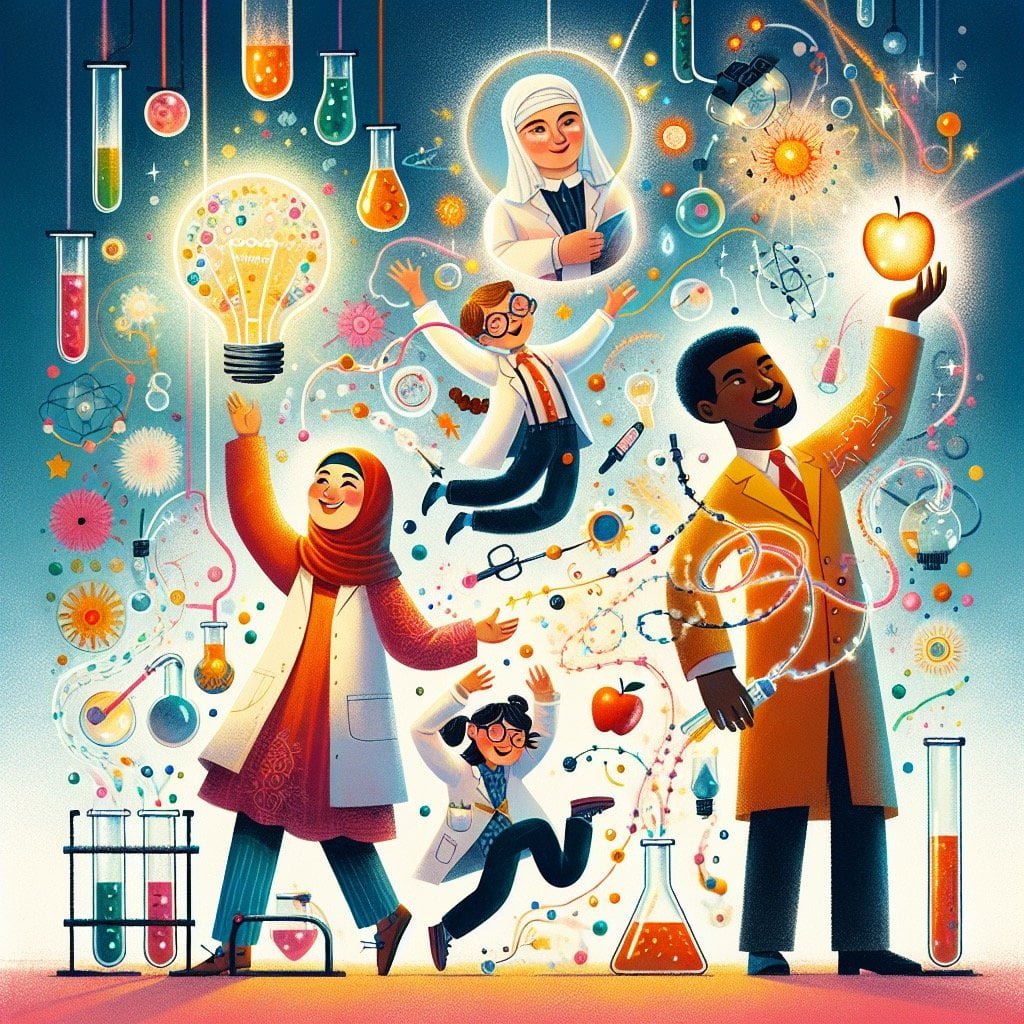Welcome to our blog post featuring a collection of fascinating and entertaining **Random Facts For Kids**! From the probability of being struck by lightning to the unique anatomy of octopuses, each fun fact is tailored to engage the curiosity of younger and older kids alike. Dive into the world of science, nature, and culture with us as we explore intriguing tidbits such as bananas being berries, honey’s everlasting shelf life, and the Eiffel Tower’s seasonal growth spurt. Join us on this educational journey filled with surprising information that will spark the imagination and leave you wanting to learn more. So, buckle up and get ready to expand your knowledge in the most delightful way possible!
Random Facts For Kids
1. The probability of being struck by lightning is around 1 in 700,000.

For younger kids: Lightning is very rare, like finding a magical treasure!
For older kids: The odds of being struck by lightning are approximately 1 in 700,000, making it a rare occurrence, but one to still take precautions against.
Detailed explanation:Random Facts For Kids:
One astonishing fact that never fails to grab one’s attention is the probability of being struck by lightning, which stands at around 1 in 700,000. This statistic may seem quite low, but when you consider the sheer number of people on Earth, it becomes clear that lightning strikes are not as rare as we might think.
Lightning is a powerful natural phenomenon that occurs when electrical charges build up in the atmosphere during a thunderstorm. These charges can be discharged in the form of a lightning bolt, which can strike the ground or even individuals. While we can take precautions to minimize the risk of being struck by lightning, such as seeking shelter during a storm and avoiding open fields or tall trees, the chances of being hit still exist.
For children, understanding the probability of being struck by lightning can serve as a valuable lesson in both science and safety. By learning about the science behind lightning strikes and the precautions that can be taken to stay safe during thunderstorms, kids can develop a greater awareness of their environment and how to protect themselves in dangerous situations.
In conclusion, the fact that the probability of being struck by lightning is around 1 in 700,000 is a striking reminder of the power of nature and the importance of staying safe during storms. By educating children about this random fact and the science behind it, we can help instill a sense of curiosity and caution when it comes to natural phenomena.
Random Facts For Kids
2. Bananas are berries, but strawberries aren’t berries.

For younger kids: Bananas are berries, but strawberries are not berries, even though we call them that!
For older kids: Botanically speaking, bananas qualify as berries due to their seeds inside, while strawberries are not berries because their seeds are on the outside surface.
Detailed explanation:Random Facts For Kids: Bananas, despite their popular classification as a fruit, are actually considered berries from a botanical standpoint. This is due to the fact that they develop from a single ovary and contain seeds. In botanical terms, a berry is defined as a fleshy fruit produced from a single ovary that contains one or more seeds embedded within the flesh.
On the other hand, strawberries, which are commonly referred to as berries, do not meet the botanical definition of a berry. Despite their name, strawberries develop from a flower with multiple ovaries, each producing a seed on the outside of the fruit. This disqualifies them from being classified as true berries.
The distinction between bananas and strawberries being berries or not may seem trivial, but it offers an interesting insight into the world of botany. It highlights how common perceptions and popular classifications can differ from scientific definitions and criteria. This fact can also serve as a great educational tidbit for children who are curious about the natural world around them.
In conclusion, while bananas may not fit the typical image of a berry, they are indeed classified as berries in the botanical world. On the other hand, strawberries, despite their misleading name, do not qualify as berries according to botanical standards. Learning about these distinctions can be a fun way for kids to engage with science and expand their understanding of the plant kingdom.
Random Facts For Kids
3. Sloths only go to the bathroom once a week.

For younger kids: Sloths only use the bathroom once a week—talk about patience!
For older kids: Sloths have a slow metabolism and go to the bathroom roughly once a week, a necessary adaptation to their energy-saving lifestyle in the wild.
Detailed explanation:Sloths are fascinating creatures known for their slow movements and unique lifestyle. One interesting fact about sloths is that they only go to the bathroom once a week. This may seem like a long time to hold it in, but there are evolutionary reasons behind this behavior.
Sloths have a very slow metabolism, which means that they digest their food at a much slower rate than other animals. This slow digestion process allows them to extract as many nutrients as possible from their plant-based diet. As a result, sloths only need to defecate once a week because their bodies are able to efficiently use up the majority of the food they consume.
Another reason sloths only go to the bathroom infrequently is related to their lifestyle in the canopy of trees. Sloths spend the majority of their time hanging upside down from branches, which makes it difficult for them to move around easily. By minimizing the number of times they need to descend from the trees to defecate, sloths reduce their risk of being exposed to predators on the ground.
In conclusion, the fact that sloths only go to the bathroom once a week is a fascinating adaptation that allows them to conserve energy, extract maximum nutrients from their food, and minimize their exposure to threats in their environment. This unique behavior makes sloths a truly remarkable and intriguing species of animal. Random Facts For Kids like this one can help children learn about the incredible diversity of the natural world.
Random Facts For Kids
4. Honey never spoils – it can last thousands of years.

For younger kids: Honey lasts a super long time, even longer than a time-travel adventure!
For older kids: Due to its low water content and acidic pH, honey can last for thousands of years without spoiling, making it one of the most durable foods known to man.
Detailed explanation:Honey, a sweet and viscous fluid produced by bees from the nectar of flowers, is a truly remarkable substance that has been prized by humans for centuries. One of the most intriguing facts about honey is that it never spoils – it can last thousands of years without going bad. This amazing quality is due to several factors that make honey a natural preservative.
The high sugar content of honey is a key factor in its long-lasting shelf life. Honey is composed primarily of sugars like fructose and glucose, which are hygroscopic, meaning they contain very little water. This low moisture content creates an environment that is inhospitable to bacteria and other microorganisms that would typically cause food to spoil. In addition, the acidic pH of honey also helps inhibit the growth of these spoilage-causing organisms.
Another important factor in the preservation of honey is the presence of hydrogen peroxide and other antimicrobial compounds. Bees add enzymes to the nectar during the honey-making process, which create hydrogen peroxide as a byproduct. This compound has antibacterial properties that further protect honey from spoiling.
Overall, the combination of low moisture content, acidic pH, and antimicrobial compounds make honey virtually indestructible. Whether stored in a cool, dark pantry or buried in an ancient Egyptian tomb, honey has the incredible ability to remain edible for thousands of years. So, the next time you enjoy a spoonful of honey, remember that this golden elixir is not just delicious, but also a fascinating example of nature’s own preservation techniques. Random Facts For Kids like this one can spark curiosity and wonder about the amazing world around us.
Random Facts For Kids
5. The Eiffel Tower can be 15 cm taller during the summer.

For younger kids: The Eiffel Tower grows taller like plants in the summer!
For older kids: The Eiffel Tower’s iron frame expands in the summer heat, making it grow up to 15 cm taller during warm months due to thermal expansion.
Detailed explanation:Random Facts For Kids – Have you ever noticed that the Eiffel Tower can actually be 15 cm taller during the summer? This fascinating phenomenon is due to the expansion of the iron structure when exposed to heat.
The Eiffel Tower, standing tall at 1,063 feet, is made of iron. Iron is known to expand when temperatures rise and contract when temperatures drop. During the hot summer months, the sun beating down on the Eiffel Tower causes the iron to expand slightly, adding to its overall height. This expansion can make the iconic landmark up to 15 cm taller than it is during the cooler months of the year.
This increase in height may not be noticeable to the naked eye, but it is a scientifically proven fact. Engineers and researchers have studied this phenomenon and have confirmed that the Eiffel Tower does indeed grow taller in the summer.
So, the next time you visit Paris and gaze up at the majestic Eiffel Tower, remember that its height can change throughout the year. This Random Facts For Kids about the Eiffel Tower showcases how even well-known landmarks can hold fascinating secrets and surprises.
Random Facts For Kids
6. Octopuses have three hearts and blue blood.

For younger kids: Octopuses have three hearts and blue blood, just like superheroes!
For older kids: In a fascinating twist, octopuses boast three hearts and copper-based blue blood, unlike humans, illustrating their unique anatomy and adaptation to the ocean.
Detailed explanation:Octopuses are fascinating creatures that are known for their unique biological characteristics. One intriguing fact about octopuses is that they have three hearts and blue blood. To understand why octopuses have three hearts, it is important to know a little bit about their anatomy.
The main heart of an octopus is responsible for pumping blood throughout the body. This heart is located in the octopus’s head and is connected to the two smaller hearts located near the gills. These two smaller hearts are responsible for pumping blood to the gills, where oxygen is absorbed from the water. The deoxygenated blood then flows back to the main heart for oxygenation before being circulated throughout the rest of the body. This unique circulatory system allows for efficient oxygen delivery to the octopus’s tissues, helping to support its active lifestyle.
In addition to having three hearts, another interesting feature of an octopus’s circulatory system is the presence of blue blood. The blue color of an octopus’s blood comes from a copper-rich protein called hemocyanin, which is used to transport oxygen in the blood. In contrast, vertebrates like humans have iron-rich hemoglobin in their blood, which gives it a red color.
Overall, the fact that octopuses have three hearts and blue blood is a fascinating example of the diverse adaptations that have evolved in the animal kingdom. These unique biological features make octopuses one of the most interesting and extraordinary creatures in the ocean, making them a popular topic for Random Facts For Kids.
Random Facts For Kids
7. The unicorn is Scotland’s national animal.

For younger kids: Scotland’s national animal is a magical unicorn!
For older kids: Scotland adopted the unicorn as its national animal, representing purity, innocence, and enchantment in its folklore and heraldry.
Detailed explanation:Unicorns are often associated with magic and fantasy, but did you know that the unicorn is actually Scotland’s national animal? This may come as a surprise to many, as Scotland is more commonly known for its tartan kilts, bagpipes, and the Loch Ness Monster. However, the unicorn has been a symbol of Scotland for centuries.
The unicorn first became associated with Scotland in the 12th century when it was featured on the Scottish royal coat of arms by William I. Legend has it that the unicorn represents purity, innocence, masculinity, power, and healing. It is said that only a virgin can catch a unicorn, making it a symbol of purity and virtue.
As Scotland’s national animal, the unicorn can be seen on various emblems, including the Royal Arms of Scotland and on coins. The unicorn is often depicted as a white horse-like creature with a spiraling horn on its forehead. It is considered a symbol of strength and grace.
Despite its mythical origins, the unicorn holds a special place in Scottish culture and is a beloved symbol of the country. So, next time you think of Scotland, remember that the unicorn is proudly standing as its national animal.
In conclusion, the unicorn being Scotland’s national animal may seem like a whimsical choice, but it holds deep cultural and historical significance for the country. It represents purity, strength, and grace, making it a fitting symbol for Scotland. Next time you come across this random fact for kids, remember the proud unicorn of Scotland.
Random Facts For Kids
8. The smell of freshly cut grass is a plant distress call.

For younger kids: When you smell freshly cut grass, the grass is talking to other plants!”
For older kids: The distinctive scent of freshly cut grass is actually a chemical compound released by the grass when it’s wounded, acting as a distress call to nearby plants.
Detailed explanation:When you step outside on a sunny day and catch a whiff of the fresh, earthy scent of freshly cut grass, you may not realize that what you are actually smelling is a plant distress call. This seemingly pleasant aroma is actually a chemical signal that the grass releases when it is wounded, such as when it is cut by a lawnmower.
Plants have evolved the ability to release volatile organic compounds (VOCs) in response to stress or damage. When grass is cut, it releases these VOCs as a way to communicate with other plants and possibly even warn them of potential danger. The scent of freshly cut grass is a result of these VOCs being released into the air, where they can be detected by humans.
Scientists believe that this plant distress call serves a few different purposes. One theory is that by releasing VOCs, the grass is signaling to nearby plants that they should start to defend themselves against potential threats, such as herbivores. Another theory is that the smell of freshly cut grass may actually attract predators of herbivores, helping to protect the grass from further damage.
In conclusion, the pleasant smell of freshly cut grass is not just a byproduct of the mowing process – it is actually a complex chemical signal that the grass is using to communicate with other plants and potentially protect itself. So the next time you take a deep breath of that fresh grass scent, remember that you are actually experiencing a fascinating example of plant communication and defense mechanisms.
Random Facts For Kids
9. A single strand of spaghetti is called a ‘spaghetto’.

For younger kids: One piece of spaghetti is called a ‘spaghetto’—such a fun name!
For older kids: Surprisingly, a solitary strand of spaghetti is known as a ‘spaghetto’ in its singular form, carrying on the quirky nature of the Italian language.
Detailed explanation:Random Facts For Kids can be a source of amusement and intrigue for young minds, and the fact that a single strand of spaghetti is referred to as a ‘spaghetto’ certainly fits the bill. The word ‘spaghetto’ is actually the singular form of ‘spaghetti’ in Italian, which is the language from where the term originates.
Spaghetti is a type of pasta that is typically long, thin, and cylindrical in shape. When cooked, it becomes soft and flexible, making it easy to twirl around a fork. However, when it is in its dry form, spaghetti is fragile and rigid – characteristics that are perhaps less known to kids.
The concept of a single strand of spaghetti having its own unique name can be fascinating to children, as it adds an element of individuality to an otherwise mundane object. By learning this peculiar piece of information, kids can also gain insight into the Italian language and culture, broadening their understanding of the world around them.
Furthermore, understanding the term ‘spaghetto’ can also be a fun way to introduce kids to the idea of singular and plural forms of words in different languages. It showcases the diversity of language and the nuances that exist within it, sparking curiosity and prompting further exploration.
Overall, the fact that a single strand of spaghetti is called a ‘spaghetto’ is a quirky tidbit that can entertain and educate children, making it a perfect addition to the collection of Random Facts For Kids.
Random Facts For Kids
10. Brazil is named after a tree, not the other way around.

For younger kids: Brazil is a country named after a tree—it’s like a secret code!
For older kids: The country of Brazil was named after a type of tree called ‘Pau-Brasil’, known for its reddish wood dye, and not the other way around, highlighting an interesting historical origin.
Detailed explanation:Brazil is a country in South America known for its vibrant culture, diverse wildlife, and lush rainforests. But many people may not know that the country actually got its name from a tree, not the other way around. The Brazilwood tree, also known as Paubrasilia echinata, played a significant role in shaping the history of the country and ultimately giving it its name.
The Brazilwood tree was highly prized for its deep red wood, which was used in the production of dye. The dye produced from the tree’s wood was a valuable commodity in Europe during the 16th century, where it was used to color fabrics and textiles. The tree became so closely associated with the region that the land came to be known as Brazil, after the Portuguese word for the tree, “pau-brasil.”
The Portuguese explorers who arrived in the region in the early 1500s were drawn to the abundance of Brazilwood trees along the coastline. They soon established colonies and began exporting the valuable dye back to Europe. As demand for the dye grew, so did the extraction of Brazilwood, leading to extensive deforestation and the eventual decline of the tree in the region.
Today, Brazilwood trees are a protected species, and efforts are being made to conserve and restore their populations in Brazil. The legacy of the tree lives on in the name of the country, reminding us of the important role that nature plays in shaping our history and culture.
In conclusion, the fact that Brazil is named after a tree highlights the fascinating connections between nature and human history, shedding light on the origins of the country’s unique name. This is just one of the many interesting and educational random facts for kids that can spark curiosity and wonder about the world around us.
Did you know?
Did you know that there are more possible iterations of a game of chess than there are atoms in the known universe?
Summary of Random Facts For Kids
Are you looking for some fascinating and fun facts to share with your kids? Look no further! In this blog post, we explore a range of intriguing tidbits that are sure to spark the curiosity of young minds. From the rarity of being struck by lightning to the surprising fact that bananas are berries and strawberries are not, there is so much to learn and discover. Did you know that sloths only go to the bathroom once a week, or that honey can last thousands of years without spoiling? And how about the Eiffel Tower growing taller in the summer or octopuses having three hearts and blue blood? These amazing facts, along with the revelation that Scotland’s national animal is a unicorn, the intriguing reason behind the smell of freshly cut grass, and the quirky fact that a single strand of spaghetti is called a ‘spaghetto’, will surely captivate kids of all ages. And did you know that Brazil is named after a tree, not the other way around? These random facts are not only entertaining but also educational, providing insight into the natural world, history, and language. So, if you want to pique your child’s interest and expand their knowledge in a fun and engaging way, be sure to dive into the world of random facts for kids in this exciting blog post!
Sources and additional information for Random Facts For Kids
None




